|
FAQs about Giant Clam Disease, Pests &
Predators 7
Related Articles: Example Chapter
from NMA Reef Invertebrates book, on Giant Clams, Tridacnids, A Brief
Guide to the Selection and Placement of Tridacnid
Clams by Barry Neigut,
Bivalves,
Mollusks, Lighting Marine
Invertebrates,
Related FAQs: Tridacnid Health: Pinched
Mantle Syndrome in Giant Clams by Dr. David Basti, Deborah
Bouchard & Barry Neigut, Tridacnid Disease 1, Tridacnid Disease 2, Tridacnid Disease 3, Tridacnid Health 4, Tridacnid Health 5, Tridacnid Disease 6, Tridacnid Disease 8, & Pest Snails (Pyramidellids...),
FAQs on Giant Clam Disease by Category:
Diagnosis,
Environmental, Nutritional,
Social, Trauma,
Pathogenic,
Treatments
Tridacnid Identification, Tridacnid Selection, Tridacnid Compatibility, Tridacnid Systems, Tridacnid Lighting, Tridacnid Placement, Tridacnid Feeding, Tridacnid Reproduction, Tridacnids 1, Tridacnids 2, Tridacnids 3, Tridacnids 4, Tridacnid Clam Business, Bivalves, Bivalves 2, Lighting Marine
Invertebrates,
|
|
|
Derasa Clam Issue
1/28/18
Bob,
<Eric; 11 megs of pix?>
When it rains it pours I guess. Multiple issues with the reef and now it seems
my 11 year old Derasa Clam is on its way out. From my experience when a clam
starts looking off that is usually the end. However the clam
seems to be trying to open and randomly closing. Its basically closed the
majority of the time now. I did the usual; looked for snails, crabs, or anything
else that could be irritating the clam and nothing. I did notice however what
appeared to be a Bristleworm in the byssal foot area. I am pretty sure it was an
innocent bystander but wonder if it could be the culprit irritating the clam
causing it to close.
<Might be before or after...>
It looks like it is moving in and out of the clam. I am running out of thoughts
here. Water Parameters are spot on. Everything else seems to be fine. I attached
a few pics. Its a beauty and I have had it forever and would hate to lose it.
Thanks,
Eric
<Is there any other life showing odd signs here? You have checked your water
parameters, checked the test gear? Any odd/detectable smells? Bob Fenner>
|
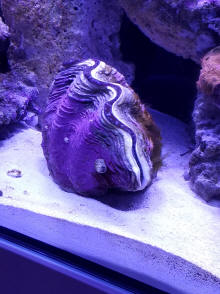 |
|
Re: Derasa Clam Issue 1/29/18
Sorry for the large photos, lol. The phone cameras these days.
Everything else looks good water may be a bit to clean but the clam has constant
growth so do not think that is an issue. The two basics cal (420) and Alk (10.1)
are both spot on. What's odd is the clam is frequently blowing water out hard
through the siphon which I assume it means something is irritating it right?
<I would interpret this as such, yes>
It looks like a spawning event but without the spawn if you know what I mean. If
it was wasting away would it have the strength to open and close like that?
<Perhaps. Bob Fenner>
|
Re: Derasa Clam Issue 2/4/18
Bob,
<Eric>
Sorry for the large pictures? <Then why send them? Re-size...>
The clam is looking better in some ways. Its
extending the mantle now however it is gaping at the mouth pretty bad.
Since its mouth is wide open I got the pleasure of taking a peak inside.
Underneath the gills there looks like a piece of bone or cartridge. Do you know
what this is?
<What I can make out is natural... supportive structure>
Should there be meat on there or something? Any chance this the pulls through?
<Yes. BobF>
|
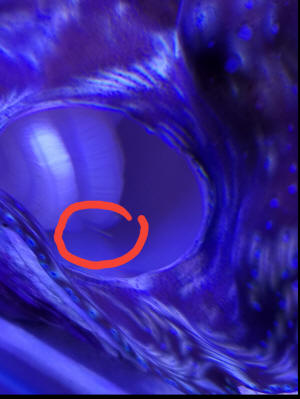 |
|
|
Crypt, velvet or infection? ID help, please...
12/10/15
<Six plus megs of uncropped pix? Why?>
Greetings! I'm unfortunately without microscope and would appreciate some input
on the current malady I see in my tank if you would be so kind.
<How could I, or anyone tell from these images?>
300g tank.
About 30 SPS frags.
Hippo tang.
Three yellow tangs.
Pajama cardinal.
Six line wrasse.
Eight blue green reef Chromis.
Peppermint shrimp.
Skunk cleaner shrimp.
Tank is a year old. It was moved a year ago from being set up for 12 years
and all livestock was given away. It has all the same live rock as before.
Fish have all been in tank for four months. Corals for about 5 months, with one
being introduced 2 months ago.
Three days ago I did a flatworm exit treatment since I was
finally sick of siphoning out hundreds of flatworms with each weekly water
change. All seemed to go well, and I did a 25% water change at the end, as well
as running activated carbon in a reactor for a day and siphoning as many dead
worms as I could.
Around that time I noticed a little white area on the hippo tang's forehead.
Since then it has grown to a full white forehead and a white spot on either
side. I have attached a picture.
<.... looks like a scratch on the flank.... Physical trauma>
I don't know if I am seeing things or the yellow tangs seem like they may have a
white sheen over their whole bodies, but it is only visible when looking at the
fish from the front. From side view they look normal.
The cardinal seems fine. Six line wrasse seems fine. Chromis' seem fine,
although one of them seems to have a physical injury and a little brown spot in
the side.
None of the fish have been scratching. None are breathing rapidly. All have
voracious appetites, with the hippo tang being the most voracious. No hiding.
All swimming out in the open. Gills are not swollen.
Could you please check the picture and my descriptions and tell me if you think
it is crypt or velvet, or possibly some sort of infection brought on by lowered
immune systems due to toxins from the flatworm treatment?
<Can't tell anything from the pix, description>
I would think if it was velvet everything would be dead already, and I am ready
to try and catch all fish and place in a hospital tank and treat if it is
necessary.
<... no need to move, yes to Velvet>
Please let me know if the picture doesn't come through. I appreciate all that
you do! You guys helped immensely many years ago and all has been smooth sailing
in my tank until this incident.
Thank you! I look forward to your reply.
Thomas Bolton
<Don't panic! Bob Fenner>
|
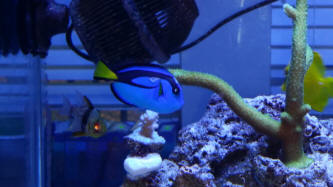
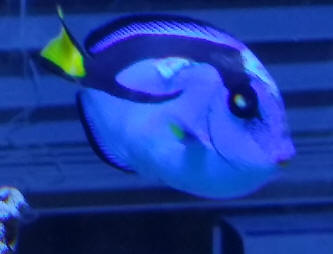 crop
crop |
|
Too much light for a squamosa clam?
11/21/14
Good evening WWM Crew,
<Good morrow Wendy>
Thank you for helping people (me) do a better job caring for reef
creatures.
<A pleasure, honor and desirable duty>
I scour this web site for all sorts of questions and it has been a
tremendous guide.
Ok, here is the question. Why is my Tridacna squamosa clam browning out?
<Could be a few influences. Happily, am in the process of penning a pc.
for CORU on "Top Tridacnids"; so am more familiar with their husbandry
right now>
I believe that I may have too much light, here is why...
165 mixed reef
3 years old
pair clowns, pair Banggai cardinals, Red Sea sail fin tang, various
hermits,
<Do keep your eyes on these false crabs... can "bug" clams>
3 BTA (keep splitting and I keep the LFS supplied with extras), snails
sps, lps, softies (Montiporas and birds nests doing great, giant
frogspawn and Fungia very happy, Zoanthids open, Ricordeas plump, 2
leathers are full, BTAs at top of tank and happy, chalices growing,
trumpets multiplying)
Aqua C EV240 skimmer, LifeReef Sump, LifeReef Calcium reactor, refugium,
mp 40 power head
1.025 specific gravity
80 average temp
440 calcium
11.5 Alk
1360 magnesium
.04 Iodine
8.2 pH
.03 Fe
<All of the above are fine>
undetectable phosphates
<THIS is trouble. All life needs "some" soluble phosphate...
Whatever means you're employing to extract directly I'd cut back or
remove... AND/OR increase your feeding to the point of registering some
HPO4>
Those are today's readings and they fluctuate very little.
20% water changes each week
The tank is 72" long and 27" deep and 17" wide.
1 Orphek 156 on left side, 1 Orphek 156 on right side, 1 Orphek 72 spot
in middle, 2 Orphek moon light spots in middle, 4 t5 bulbs framing it
all in. Orphek 156 are 8" above water. 72 spot is 12" above water. t5's
are 14" above water.
<Mmm; these are good fixtures, lights, and I doubt that they're too
bright/intense. You might want to borrow a PUR or PAR meter (likely your
LFS have one to lend; considering the gear you list)... and try the
sensor down near the clam>
Clam was first placed in middle of tank on sand under 72 spot, after a
month the clam moved 10" to be under a 156 and tucked against a rock
with slight shade, after 3 months in this location clam has lost its
deep brown with blue edges to be orangey brown with purple edges. Clam
mantle is about 32" away from 156. Clam is about 8", it opens fully
under day lights and closes with fish shadows or pesky hermit crabs.
<Good>
I have seen a 1/2" bristle worm under the mantle once.
<Not likely trouble. There are a Bazillion (a bunch) of Errantiate
Polychaetes in most all marine environments>
Clam allowed clown pair to lounge in it originally, but now does not.
Clowns do not pester clam, no other fish bother it, hermits seem to
annoy it now when they work on shell.
Should I try to dim 156s to 80%?
Lighting Schedule:
t5's on at 9 am off at 7 pm
72 spot on at 10 am off at 6 pm
156 day lights on at 11 am and off at 7 pm
156 moon lights on 7 pm to 10 pm
spot moons in center of tank, 20" above water, on 24 hours
<This is all fine as well>
Thank you.
Wendy
<I would focus on the Phosphate alone here; and try to get those light
meter readings. Cheers, Bob Fenner>
|
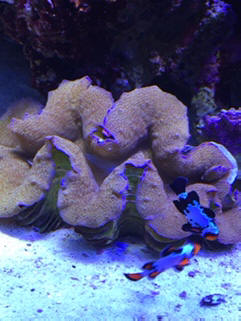 |
Hair algae growing inside a clam
12/3/13
Hello WWM Crew,
<Thierry>
I have a problem with a Tridacna clam for which I haven't found an
answer yet.
Some hair algae started to grow on one side of the clam. I didn't take
care of it right away as I was battling these algaes all over my tank. I
have now won the battle but I noticed that some algae managed to attach
on the inside edge of the shell (note : the algaes I thought were green
hair algaes, the ones remaining still look like hair algae but
are red-brown and less soft than the green ones).
<Could be... most anything... not necessarily a Chlorophyte. One can't
"tell" the taxonomic group (Division) of algae simply on the basis of
color. Requires microscopic examination and sometimes other testing
(storage foods et al.)>
It is apparently causing discomfort to the clam as the
mantle stays retracted on this area. I've tried to remove the algaes
several time but I cannot get to the root so I am only breaking the tips
away. It has now been several weeks and I am afraid it will eventually
cause the clam to die. I have several hermit crabs and snails but they
don't seem to either care for this type of algae or don't want to go
inside the clam. The only solution which comes to my mind is to block
the shell with a little piece of wood so that the clam cannot close it
and use tweezers to thoroughly remove the algaes.
However, I am afraid this solution will stress the clam and possibly
kill it. Do you have any other suggestion ?
<... this may be Cyanobacteria... or that in origin, accompaniment...
This IS one case where I would avail myself the use of antibiotics...
Erythromycin of a few sorts is sold in the trade/interest... I would
move the clam to a system w/o other life that might be mal-affected for
this treatment. Search WWM with the terms "chemical algaecides"; read
particularly re BGA>
Thank you
Best regards,
Thierry
Switzerland
<Welcome. Bob Fenner, USA>
Re: Hair algae growing inside a clam
12/3/13
Hello Bob,
<Thierry>
Thank you for replying so quickly.
As far as I can tell, the algaes look more like Polysiphonia or
Asaragopsis than Cyanobacteria.
<... again; 'scope... lack of plasmids, nucleus, plasmalemma....
circular single strand of DNA...>
Would chemical removal work as well ? Will it leave the clam unharmed ?
<... IF, then... only BGA treated thus; and in isolation, proper dosage,
maintained conditions...>
What about mechanical removal while keeping the clam open, risky or
assured major damage ?
<I would not continue the mech. means... you need the clam to have good
health and other organisms (biofilm) to settle, occupy the area>
Thank you and best regards
Thierry
<Am hoping this is clearer. BobF>
Re: Hair algae growing inside a clam from 12/3/13
1/16/14
Hello Bob,
<Big T!>
I never properly thanked you for your advice.
So thank you for your answers, thank you for your website and all the
best in 2014.
<Ah, thank you. BobF>
Best regards
Thierry
|
Help with clam gaping
6/14/13
> I'm hoping someone can help me with my maxima clam. I purchased it from
Pacific East Aquaculture on May 18 at a frag swap. It looked like it was
doing great for over the first three weeks - mantle extended, responsive
when the fish moved over it, new shell growth, intake siphon in a normal
shape, etc.>
> This past Tuesday evening, I noticed the clam was holding its intake
siphon open more than usual. I did some research and saw this could be due
to stress.
<... more likely... Read here:
http://www.wetwebmedia.com/ca/volume_6/volume_6_4/clams.html
and the linked files at the bottom>
No corals are near the clam and my water parameters were in line, but the
clam had moved a bit and it looked like the mantle was being moved by the
powerheads. I moved the clam slightly back away from the flow on Wednesday
morning and made sure it was sitting on a flat rock. Here's the picture
after I moved the clam. It seemed happy the rest of the day, but Wednesday
night, the intake siphon was open more than usual again.
> On Thursday morning, I decided maybe the clam needed a little more light,
so I increased the intensity of my EcoTech Radion LEDs from 70% to 75%. I
run the Radions from 10am to 11pm in the natural mode. The clam has been
placed directly below one of the pucks of the since I brought it home. I
also added 1 tsp of reef buffer and 1 capful of AquaVitro calcification to
bring up alkalinity and calcium slightly because they were 8.0 and 410,
respectively, when I tested Wednesday night (my tank is 125 gallons)
Magnesium was 1320 and specific gravity was 1.025. I use a chiller, so my
temp is always between 77.5 and 79 degrees. The clam looked happy yesterday
during the day, but in the evening, the intake siphon was held open again,
as you can see in this picture below.
> When I woke up this morning, the clam looked like this.
Once the lights turned on, the clam started to look a little better. Here
are some pictures from about an hour ago. I also included some wider shots
so you can see the placement in my tank.
I tested my water this morning with these results:
Temp: 78
SG: 1.025
pH: (in am) 8.17 (apex probe)
Ammonia: 0 (API)
Nitrite: 0 (API)
Nitrate: 8 (Salifert)
Phosphate: 0.5 (API)
Alk: 8.3 (Salifert)
Calcium: 405 (Salifert)
Magnesium: 1350 (Salifert)
<These are all fine>
Any ideas what may be wrong with my clam and what I should do to help it?
Thanks for any advice.
Erica
<Can only guess... perhaps an animal inside the system, maybe in the clam
itself bothering it... I'd dose (3X) iodide-ate and be observant. Bob
Fenner>
|
.jpg) .jpg) |
Re: Help with clam gaping
6/14/13
Thanks for the advice, Bob. I will read all of the information you attached.
For the iodide/ate, do you mean I should do one dose three separate times
(like one dose each of the next three days) or 3 times a normal dose all at
once.
<Either will be fine. I'd do all at once now.>
Thanks!
Erica
<Welcome. BobF>
Re: Help with clam gaping 6/14/13
Thanks for the quick response, Bob. I'll let you know how my clam does.
<Thank you>
Have a nice weekend,
Erica
<And you, BobF>
Fwd: Help with clam gaping 6/15/13
Hi Bob, I dosed the iodide and I was observing the clam. I found two small
snails crawling along the clam's shell.
<Ahh! The predators I alluded to earlier perhaps>
I took them off and got rid of them. They didn't appear to be the pyramid
snails.
<Oh, there are other species>
I was reading the information you sent on pinched mantle, too. Do you think
I should freshwater dip the clam or just continue to observe?
<For me, the latter>
Also, the clam definitely seems to do better when the lights are on. Now
that they are dimming for the night, the clam is looking worse. Do you think
I should keep the lights on that side of my tank on all night tonight?
<Worth trying; though I wouldn't leave on full intensity 24/7>
Thanks,
Erica
<Welcome. Bob Fenner> Re: Clown loach
6/16/13
Thanks for your help, Bob.
<Hope it helps Sue; am a huge fan of Clown Loaches. BobF>
|
|
Clam detached from shell 2/18/13
I thought I would find something on the form but everything I see is
about the clams foot or the mantle being split. My clam and now clams
don't have either. About 2yrs ago my Squamosa clam which was about 8-9in
started to year away from the shell.
<Mmm, usually real trouble. Nutrition issue, perhaps aided by some
pest/predator>
Slowly day by day it completely tore away from the shell on one side. I
assumed he would slowly waste away so I waited and waited. It's been
2yrs and he's healthy as can be but half of his shell just hangs there.
When he closes up he just pulls himself to one side and does a good job
of it. I've attached a pic to show how good he's doing. I even put a
rubber band around him for 4months to help him reattach but no luck. The
side that's not touching the shell feels like an old hard piece of
leather so it does offer some protection. Hermits even go in there to
clean him out. Now today my maxima which is about 6" has a slight tear
the same way. I introduced an elegance coral to the tank 2 days ago
which is relatively close but the closest point is not where the tear
is. Also could a sting be so powerful it tears a hole in a clam,
<Yes>
and if so why wouldn't the clam just close up?
<Might have tried>
Ultimately if its something different what could it be and how do I
prevent this one from looking like the other.
<Keep Catalaphyllia/s well away (at least a foot)... they're better kept
in silty, shaded settings (see my article on WWM re). Your Tridacnids...
am sure you're familiar w/ the basics of nutrition, supplement use,
iodide-ate... Bob Fenner>
|
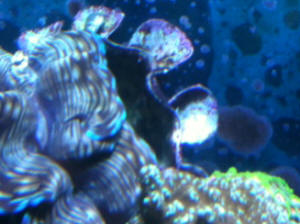
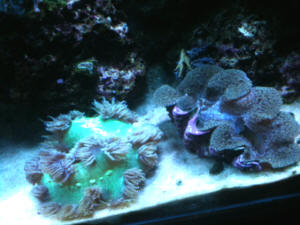 too close
too close |
Help. Domino Effect Chemical Disaster
9/7/12
Hi WetWeb Crew!
<Hello Christine>
I must be honest, I am almost embarrassed to be writing in with this issue, but
for the sake of my cherished aquarium... Well you know, I will go to great
lengths.
I thought my problem began with my maxima clam jumping all over the aquarium,
and possibly losing his byssal filament, however whatever is going on with my
clam may be the result of another issue I had months ago that I thought was
resolved, and here is my shame.
It started with a huge macro algae bloom in my aquarium, I keep most of my macro
in my sump but do enjoy a piece here and there in the display tank tucked behind
a rock as it adds a little height and movement. But it literally bloomed
to where it was choking out my corals, my nitrates were sky high and I couldn't
figure out why so I kept doing water changes. Long story short, I
ended up bringing my whole r/o unit into my lfs only to find out that the TDS
meter was faulty. Every time I did a water change I was adding more and
more nitrates into my tank.
<Happens>
I Changed out all my filters and di resin and corrected that problem, but
obviously created another with the large amounts of macro algae die off that I
was grabbing out by the handfuls for days and days so that it would not rot in
my aquarium.
I do regular water testing, but rarely test my PH, another big shame. I
assumed that since my Alk was good at around 7.9 or 8, (good range for a clam I
was told) that my buffers were doing their job. You must be shaking your
head in disbelief by now.
As my clam was still hopping around I did full water testing
Calcium 500
<Mmm, too high>
Phosphate 0
Alk/dKH 8
Mag 1480
Nitrate .20
PH 7.4. Uh oh
<Yeeikes>
So I did a lot of research on line to try and figure out why on earth my PH
would be low and my Alk be ok. Since I do not have a calcium
reactor, the only item that applied to me was low oxygen or high co2.
I do not have a glass canopy, or any canopy for that matter, but I did open the
window in the room where the aquarium is, adjusted my powerheads and overflow
returns for max surface tension, removed some pvc pipes leading into my sump so
the water now dumps into my sump rather than flows quietly through a pipe.
I have lowered my salinity to just between 1.023 and 1.024 and lowered my temp
from 76 to 74. At some point today I will be purchasing the right size
tubing to attach to my protein skimmer to allow it to suck air from the room to
make bubbles rather than using the sump water. And will add a fan as well.
I have heard that ph tests can often times be wrong,
<Not often, no>
so I took my water to my local LFS and had it tested, it showed the same
results that my test showed.
Next, and this being the only other thing I could think of, since I have a
Salifert kH/Alk test, I ran the check solution. Well low and behold the
check solution should have been 6.7 tested at 9.3! So i have been getting a
false reading for my Alk for quite some time, in which it appears higher than it
actually is. I quickly ran out and purchased an API kH test and confirmed
that my readings were somewhere around 100 ppm. Now my head is swimming.
So I have been dosing over the past 48 hours with b ionic to increase my Alk.
It is still low, according to the API test it has increased but only within a
range of between 100 and 200 ppm. I have been dosing every 24 hours to increase
on a consistent basis and not all at once.
So now you may be asking why I bored you with all that useless information about
oxygen in my tank. Well the reason for that is because while my Alk is
rising, my ph has not budged at 7.4. I understand it probably doesn't
adjust proportionately, but I performed an "oxygen test" by removing a cup of
water from my aquarium, placing an airstone in it for a few minutes and
rechecking the PH. In just those few minutes, my ph boosted to 8. So I am
still thinking I have a problem. And incidentally, which I also believe
has something to do with this whole situation, a friend of mine set up some
aquariums around the same time I upgraded from my 90 to 125. Maybe 8 or 9
months ago. I went to visit this week and the back of his aquariums are
loaded with coralline algae. I have none. Not even a little.
I know that low Alk and ph make it difficult for calcium to be absorbed.
<This is so; yes>
I have reached my limit of knowledge and understanding of water chemistry for
now, and am now turning to you for expert assistance. I can get my Alk up
to where it should be, but my ph is not moving.
<Don't worry, obsess re this... it will "come up" in time>
Other than what I mentioned above, I know of no other way to raise the o2,
except by using Kalkwasser to push out the excessive co2.
<Mmm, well... IF you want to further your physics, chem. knowledge, practical
application, you might consider adding an ozonizer (and measure for RedOx)...>
But I have no understanding or experience with Kalkwasser and read it can
actually cause damage if used improperly. And don't know if a one time
shot would be the answer.
<One time? Not really worthwhile unless one is just trying to precipitate out
phosphate>
I don't have so many corals that dosing is no longer an option. I
actually prefer to dose over having a calcium reactor.
<Okay>
Incidentally my mother, who has been recently diagnosed with lung cancer, (and
yes I may have not kept up religiously with aquarium maintenance during this
time, but managed the bare minimum) has offered use of her oxygen for a
few hours (she is NOT on liquid oxygen) if that would help infuse oxygen into my
tank and raise my PH.
<Not the route I would take, no>
The woman is a saint. However tempting as this is, I suspect that
it would only be a temporary fix even if it is a feasible idea just as adding an
airstone. I need to find the root. What else can I look for, do or test?
<Solutions... like adding a good deal more easily soluble substrate (DSB) in the
tank, sump...>
I have not been dosing calcium so I am not sure why it is at 500, unless it is a
by product of decay created from animals not being able to absorb the calcium
correctly. Or my Salifert calcium test is also inaccurate. My
lfs is retesting ALL of my result this evening when they open. Going
forward I will always have separate tests to use as confirmation for all my
testing.
And I will not assume a test is accurate just because it is expensive.
But for now, if the bottom line is that my PH remains low, as all my other
chemicals are coming back into balance, what in the world does that mean and how
do I fix it?
<Again, not to panic. Do read a while here:
http://www.wetwebmedia.com/mphtrbl.htm
I raised my clam up as well, and he has not hopped around off this higher rock.
I don't think he anchored himself to it though. He is still a beautiful
color and opens, but his mantle seems flimsy and he does not seem as quick to
respond if I wave my hand over him. But he is not dead yet and I will
continue to fight for his survival, as well as everything else in my tank that
is being affected by this imbalance.
Thank you,
Chris K
<Take your time... Bob Fenner>
Re: Help. Domino Effect Chemical Disaster
9/23/12
Hi Wet Web Crew
<Christine>
Just an update and a few more thoughts regarding my chemical imbalance
issues. Firstly, I am happy to report that I have not lost my
clam. He did re-anchor himself for a week or so, then moved again.
I have since altered my lighting schedule and moved him up to mid tank
where I am happy to say he has not moved from for a week or so, however
I am quite sure he has not anchored himself again as of yet. Sigh
<This takes time>
Sadly I am relatively certain my sandsifting starfish did not make it
through the PH ups and downs.
In a nutshell, I have added more substrate, began aerating my rodi
water for 24 hours prior to adding the salt, increased the frequency of
smaller water changes to try and lower the calcium levels and have been
dosing almost daily to try and maintain Alk of at least above 8 and
magnesium above 1200 to no avail.
<Something is up here... we need to start back "at some beginning">
I have replaced my test kits and double checked their results with my
LFS, and purchased back ups so that I could continue to double check my
results at home.
In total frustration I began earnestly reading your sight to find
any commonalities with other people who are having similar issues,
when lo<w>
and behold I found a whole thread dedicated to Coralife Reef Salt users
who are experiencing the same types of issues. I have been using
Coralife Reef salt since I upgraded to my 125 about 8 or 9 months ago.
So I mixed a batch to 1.026 and measured it. Alk was 7.4, Mag 1170
and calcium 500 (at least, as my test only goes up to 500).
I think the mystery has been solved.
<I do agree>
My tank contained mostly soft corals and a few LPS that all seemed to
look good, so I never did much water testing, that is until I got my
clam and began to notice these issues. Now in hindsight I am
beginning to notice things with some of my LPS corals that make me say
hmmm. Such as big heads of candy cane coral in which
the polyps seem to continually divide and divide, but no new branches
ever form. I could not frag them if I wanted to, as I may have up
to 7 heads on one branch. I have never seen them like this in my
LFS. That, and the lack of any coralline algae which I mentioned
in my previous email. Perhaps the high Alk and low PH is the cause
of all my Zoanthids dissolving?
<Could be>
Regardless, in reading your sight <site> I see that Tropic Marin appears
to be a good reef salt, if you have any other suggestions it would be
greatly appreciated.
<This is a superb, consistent product>
But before I change to that, do you think there would be any benefit in
using a non reef salt, like instant ocean marine salt, for several water
changes, due to its lower concentration of calcium in order to lower my
calcium faster?
<Worth trying, but I'd go w/ the TM product directly>
I realize it also has lower Mag, but I could temporarily keep that
balanced by dosing if necessary.
<Yes>
Thank you,
Chris K
<Cheers, Bob Fenner>
Re: Help. Domino Effect Chemical Disaster 9/23/12
Bob,
<Chris>
Thank you as always for your response. You mentioned that something seems
off, and needing to go back to "some beginning". I am hoping that my
lack of testing when my tank contained mostly softies, and then my
subsequent upgrade to a larger aquarium and change to what I believed was a
better salt mix at the time was the actual beginning. Incidentally, I used
Reef Crystals prior to my upgrade and the sides and back of my prior tank was
covered with coralline algae. I believed at the time everything "looked"
good, hence the lack of testing. I hope that sounds about right, because
throughout this ordeal I believed I had found the beginning of my problems
several times, only to continue to trace it back even further.
<Sorry re... am very tired, from camping, driving... the "something" is almost
certainly the suspected salt mix>
I do apologize for my previous spelling errors. I believe I was a
little bleary eyed from reading so much.
<I do understand>
And again I thank you so much for your help. Your site is invaluable and I
am certainly hoping you don't become disheartened with regulars like me.
<Not at all... in fact, it is because of intelligent, sensitive persons as
yourself that we produce WWM>
Hopefully I will see improvement from this point on, and will be happy to let
you know.
Chris K
<BobF>
I hope I did not speak too soon! Maxima Clam beh., Clownfish
comp. - 8/28/12
Hi Bob,
<Christine>
In my previous email I mentioned that my blue maxima clam and his BTA
friend were thriving in my aquarium. My clam has since left me
with a question. I hope I did not speak too soon. He was
approximately two inches when I purchased him about 8 months ago.
He has grown about a quarter of an inch since then, maybe more, but I am
sure less than a half of an inch.
<This family, species does grow slowly when small>
At the time I purchased him, I placed him inside a skeletonized half
shell of a much bigger clam that I purchased with some live rock.
I placed some substrate inside the empty half shell and placed the
little maxima clam on top. Within 24 hours he secured himself to
the shell and as far as I know has been happy as a clam ever since.
<Understandably>
Well last night he jumped shell. I found him this morning open and
beautiful, sitting in the substrate next to his old home. My first
thought was, well maybe he was outgrowing his home. My concern
came when I looked at the empty clamshell that he previously lived in.
I thought I saw the head of a feather duster worm, but upon closer
inspection it resembled a white muscle with a bunch of filaments
sticking out of it, and it was attached to the empty clamshell.
<Ohh...>
Well time to panic, right? Could this be his byssal filament?
<Yes>
Can clams leave part of it behind if they decide to move?
<Mmm, not usually>
If this is a serious problem, how long before he deteriorates, because he
still looks very colorful, is responsive opening and closing properly if
i wave my hand above him. He placed himself straight up, not on
his side or anything like that. He has not reattached himself to
anything yet, so i placed a large flat rock underneath him and the
substrate, because I really do not want him to attach himself to the
glass, I like to know that in an emergency I can relocate him if
necessary without injuring him.
<Good>
Perhaps what I saw attached to the empty clamshell was not even part of
my precious maxima. That is the best I am hoping for. OK I
just lied to you, the best I am hoping for is for you to tell me that
this is some form of asexual reproduction
<Not>
and soon I will have a another baby clam on my hands, but since I have
never run across that in any of my reading on clam care, I will chalk
that up to fantasy.
My major concern is that assuming the worst and he did leave part of his
byssal filament behind, is this normal? Can he survive it?
What are the signs of deterioration?
<Mmm, loss of responsiveness, colour...>
I have a sand sifting star, indigo dotty back, cleaner wrasse and four
clownfish. The clam is more than 6 inches away from the BTA.
Nothing that I can think of that would be picking on the maxima clam.
He is placed in the bottom of the tank where he is catching the spread
between a 10k led over the center of my tank and a 65k led on the left
side of my tank. As always, any advice would be greatly appreciated.
Incidentally Bob, if I do decide to remove a pair of my clownfish to
mate, perhaps causing the next dominant male to become female, would I
ever be able to add the clownfish back into my display tank or would
having two females cause a blood bath?
<If there's room, not usually a problem>
Thank you as always,
Christine K.
<Be of good cheer, Bob Fenner>
Re: I hope I did not speak too soon! 8/29/12
Bob thank you for your quick response. Just one more question if
you don't mind. If the clam is damaged in some way and will not
survive, how long of a deterioration process should I expect?
<Likely a few days>
In other words, when can I stop holding my breath?
<The same period>
It has been 24 hours and he looks/acts fine. If he makes it 48
hours, can I start to think he may survive?
<Yes>
Or is it more like weeks or months? I feel very confident that if
he secures himself to his new home within the next few days then I may
be out of hot water, but barring that scenario, if he continues to
look/act good, when can I start thinking we may have made it over the
hump, and besides watching him, is there anything else I can do?
<A boost (one time) in iodide-ate dosing is prudent. BobF>
Christine
|
Distressed Deresa Clam
6/20/12
Hi Crew,
<John>
I have had this Deresa clam for a year now. You can see the ridge half
way down the shell, this is where the clam was when I purchased it and
it has grown about 4 inches since that time. There has always been good
mantle extension on this specimen, and I've never seen it less than 90%
open during the light hours. Yesterday morning, however, the clam looked
like the picture below. There is a white, skin-like film that extends
from the edge of the shell, and the clam will not open more than maybe
20% .
I feed the tank DTs every third day, I skim heavy, and I do frequent
water changes. My nitrates are .5ppm, phosphates 0,
<These and most all other chemo- auto- trophs need measurable HPO4>
Alk 8, cal 420, salinity 1.026, Mag 1500.
I have a baby maxima and a 4'' crocea that are both doing fine. in fact
you can see the maxima bottom right.
<I see>
One thing that I read in one of Bob's posts is that "chemical
supplementation is a leading cause for clam death" and I'm wondering
what was meant by that?
<Too much of some commercial products, especially if haphazardly
sprinkled/poured directly on Tridacnids can be deleterious>
I dose Lugol's iodine once a week in the appropriate amounts and have
for months,
<No worries.>
I added a dose of Kent essential elements
<These additions should be made through water change outs... i.e., mixed
in w/ the new water ahead of time, NOT placed directly in the
main/display tank>
yesterday (but only after the clam was looking like this, it did not
help), and I've also been dosing an Amino Acid product for SPS, but I
have been for months and it hasn't affected anything negatively until
maybe now...could the amino acids be culprits? did I overload the clam
or something?
<Possibly the Kent product>
What do you think is going on here?
<Perhaps nothing... maybe a sting, bite from a tank mate... likely
long-term phosphate deprivation>
Do clams molt or shed after periods of intense growth?
<No>
These pictures are from yesterday, looks the same today, still responds to
stimulus.
<I'd remove whatever means of HPO4 removal you're employing... feed your
fishes a bit more... Bob Fenner>
|
.JPG)
.JPG) |
Re: Distressed Deresa Clam
6/21/12
Bob,
<Hi John>
Thank you for your diagnosis. I recall that I changed my RowaPhos media the
very day before the clam started acting up.
<Mmm, may be related events>
I've done this many times before, but it had been a few months since my
last media change and perhaps it shocked the clam or the clam got light
shock from sudden water clarity?
<Not likely the light>
The thing I don't understand is how it was able to grow so quickly if it
has been deprived of phosphates.
<Some is being "produced" from outside feeding mostly... on a
continuous/punctuated basis... You're caught in
Western/Linear/Uni-directional thought... the universe is much different>
Don't they need some measure of phosphates to build their shells just like
stony corals?
<Yes>
If you think it's appropriate I can start target feeding the clam some phyto
to boost nutrient uptake??
<"Phyto" products for aquariums are about worthless for this application
(food)... Do see my further comments re, posted/archived on WWM, in
publications elsewhere if interested. B>
John |
Dying new derasa?
4/2/12
Hi wonderful experts! I got brave a few days ago and
mail-ordered a four inch derasa clam.
<Mmm, where from? As in cultured... or
wild-collected?>
It looked totally healthy when it arrived. I gave it a four-hour
acclimation and carefully, lightly set it on the DSB aragonite
substrate.
(I've seen some experts say to avoid setting derasa's directly
on sand, and others who recommend it.)
<... should be fine... read here re:
http://www.wetwebmedia.com/ca/volume_1/cav1i3/Clam_care/Clam_care.htm>
Water parameters are great: Temperature=77, pH=8.2, calcium=410,
<Mg?>
alkalinity=9.5, ammonia, nitrite, nitrate, phosphate
unmeasurable.
<... need some HPO4, NO3... absolutely necessary
essential>
It's lit by reef-capable LEDs. There are several stony
corals in the same tank, all thriving. And one token fish, a
three-stripe damsel. No crabs, shrimp, et cetera. A handful
of small Stomatella snails and Asterinas. Lots of assorted pods
who love the live phytoplankton I feed the tank daily.
The first two days the clam looked fantastic: fully open, mantle
slightly over the lip of the shell, slowly pulsing.
The third day the clam hardly opened and the mantle was slightly
retracted from the lip.
Today, the fourth day, the mantle is retracted a good half inch below
the lip of the shell, even coming unattached from the shell in a few
places, and the intake hole is gaping wide.
<Not good>
Now I am tempted to just pull it from the tank and toss it, because I
don't want it to die and nuke the whole tank. Or is this just
shipping stress?
But it was doing fabulously for the first two days, and now two days
later it looks like it's rapidly dying. Any thoughts?
Thanks!
Tim
<Could be lack of nutrient, imbalance of Mg w/ Ca... an
imported pathogenic disease... Read here: http://www.wetwebmedia.com/HighInvertInd.htm
scroll down to the tray on Bivalves, Giant Clams. Bob
Fenner>
Re: Dying new derasa? 4/2/12
"Could be lack of nutrient, imbalance of Mg w/ Ca... an imported
pathogenic disease"
Bob - Thanks for the quick reply! It's a moot point now,
because the clam was so deteriorated this morning that I got rid of
it... too risky for the rest of the tank. I noticed that the foot
was completely disintegrated, tattered and almost gone. But
I'm still left with the curiosity of its manner and rate of
death.
<MANY such clams are virtually DOA collected from the wild;
particularly from Vietnam>
For two days it thrived, and then suddenly, literally overnight,
it began to die. Within two more days it was
disintegrating! I had that clam for only four days, and the first
two days it looked great. Would any of the items you suggested
have caused nearly instantaneous transition from thriving to rapidly
dying? (I'm not questioning you... I just don't know,
even after reading a lot on WWM and two entire books on giant
clams.) It's as if someone poured poison in the tank, but
this certainly did not happen.
It's just my wife and me here. Also, I have a half
dozen peaceful stony corals in the tank, and they are all in excellent
shape, as well as the one fish.
I read somewhere that clams do not like air bubbles inside them.
The shipping bag was not full of water. If it was jostled a lot
during shipping, air likely would have entered the clam. Might
this be the cause of this rapid death?
Tim
<Please read where you've been referred.
B>
|
What is growing on my Crocea
Clam?/Ascidian ID 3/23/12
Good evening folks,
<Hello Justin>
I purchased this Crocea clam from the LFS roughly three weeks
ago. Last evening, I noticed this hitchhiker and I’m
curious what it may be. The clam is 3” – 3.5”, so the
hitchhiker pictured is fairly small. I noticed it when the
clam retracted its mantle in response to the light array
transitioning to night mode. It does not appear to have a
shell of any kind. Like the clam, it responds to
light/shadow changes by retracting what appear to be its
siphons. I did not notice this critter when I purchased the
clam and my QT does not have lighting adequate for the clams
requirements so it went directly into the display tank after a
drip acclimation. Any help identifying the creature and
risks would be wonderful!
<Appears to be an Ascidian, a Tunicate and pose no risks to
other life. Is not uncommon to see Tunicates attached to
bivalves in the wild.>
Incidentally, my apologies for the poor color balance of the
photo. My camera phone does not take accurately
representative photos under fluorescent lighting.
<No problem.>
Thank you,
<You're welcome. James (Salty Dog)>
Justin
|
|
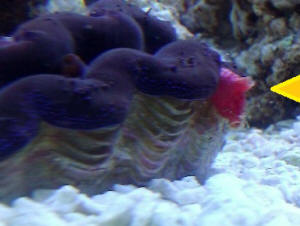
|
|
Baby clam?/Clam ID?
3/1/12
I found this attached to my new crocea clam. At first I just
thought it was a piece of old shell from maybe another clam. I
tried to (gently) to pull it off but it's good and stuck, but
pliable. Since I got the crocea the little piece has moved up
it's shell maybe 1/4 inch. Yesterday I noticed that it reacts
to shadows just like my crocea - slams shut and pulls in the
little white frill you can see on its upper edge. Could it be a
baby crocea? Maybe some other type of clam or oyster? I can't
seem to hunt down any pictures online of a crocea that small. Any
ideas?
<Do you like oysters on the half shell?>
Thanks
<You're welcome. James (Salty Dog)>
Angela
|
|
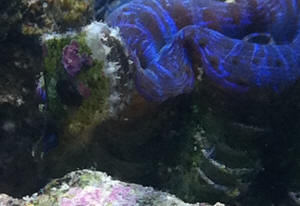 Bivalve, Pinna? B Bivalve, Pinna? B
|
Re Baby clam?/Clam ID? 3/1/12
Sorry if I seem daft but you're saying this is in fact an
oyster? Would it hurt to leave it?
<Sure looks like an oyster to me if what I'm looking at is
what you are referring to. Is fine to leave in the
system.>
Thanks again
<You're welcome Angela. James (Salty Dog)>
Angela |
|
|

